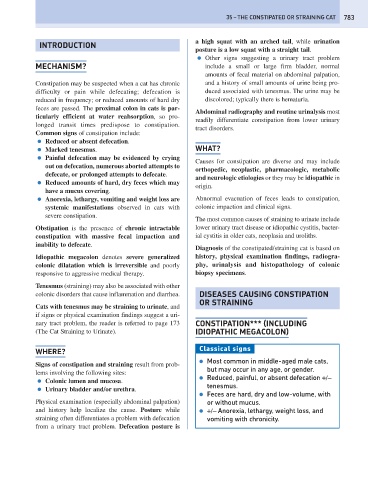Page 791 - Problem-Based Feline Medicine
P. 791
35 – THE CONSTIPATED OR STRAINING CAT 783
a high squat with an arched tail, while urination
INTRODUCTION
posture is a low squat with a straight tail.
● Other signs suggesting a urinary tract problem
MECHANISM? include a small or large firm bladder, normal
amounts of fecal material on abdominal palpation,
Constipation may be suspected when a cat has chronic and a history of small amounts of urine being pro-
difficulty or pain while defecating; defecation is duced associated with tenesmus. The urine may be
reduced in frequency; or reduced amounts of hard dry discolored; typically there is hematuria.
feces are passed. The proximal colon in cats is par-
Abdominal radiography and routine urinalysis most
ticularly efficient at water reabsorption, so pro-
readily differentiate constipation from lower urinary
longed transit times predispose to constipation.
tract disorders.
Common signs of constipation include:
● Reduced or absent defecation.
● Marked tenesmus. WHAT?
● Painful defecation may be evidenced by crying
Causes for constipation are diverse and may include
out on defecation, numerous aborted attempts to
orthopedic, neoplastic, pharmacologic, metabolic
defecate, or prolonged attempts to defecate.
and neurologic etiologies or they may be idiopathic in
● Reduced amounts of hard, dry feces which may
origin.
have a mucus covering.
● Anorexia, lethargy, vomiting and weight loss are Abnormal evacuation of feces leads to constipation,
systemic manifestations observed in cats with colonic impaction and clinical signs.
severe constipation.
The most common causes of straining to urinate include
Obstipation is the presence of chronic intractable lower urinary tract disease or idiopathic cystitis, bacter-
constipation with massive fecal impaction and ial cystitis in older cats, neoplasia and uroliths.
inability to defecate.
Diagnosis of the constipated/straining cat is based on
Idiopathic megacolon denotes severe generalized history, physical examination findings, radiogra-
colonic dilatation which is irreversible and poorly phy, urinalysis and histopathology of colonic
responsive to aggressive medical therapy. biopsy specimens.
Tenesmus (straining) may also be associated with other
colonic disorders that cause inflammation and diarrhea. DISEASES CAUSING CONSTIPATION
OR STRAINING
Cats with tenesmus may be straining to urinate, and
if signs or physical examination findings suggest a uri-
nary tract problem, the reader is referred to page 173 CONSTIPATION*** (INCLUDING
(The Cat Straining to Urinate). IDIOPATHIC MEGACOLON)
WHERE? Classical signs
● Most common in middle-aged male cats,
Signs of constipation and straining result from prob-
but may occur in any age, or gender.
lems involving the following sites:
● Reduced, painful, or absent defecation +/-
● Colonic lumen and mucosa.
tenesmus.
● Urinary bladder and/or urethra.
● Feces are hard, dry and low-volume, with
Physical examination (especially abdominal palpation) or without mucus.
and history help localize the cause. Posture while ● +/- Anorexia, lethargy, weight loss, and
straining often differentiates a problem with defecation vomiting with chronicity.
from a urinary tract problem. Defecation posture is

